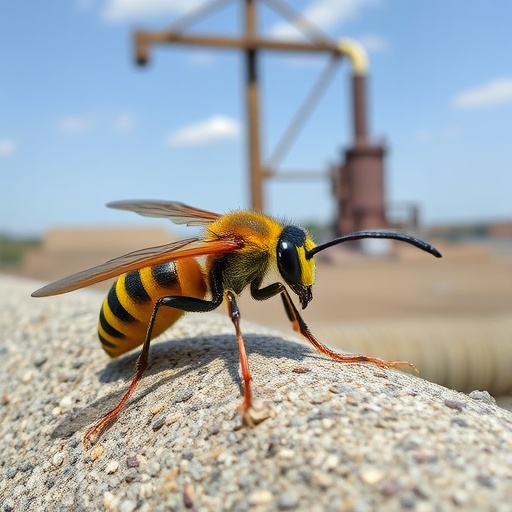In a groundbreaking study that raises significant concerns about environmental contamination and its impacts on biodiversity, researchers have examined the levels of arsenic exposure in insects inhabiting green spaces adjacent to a former copper smelter. The compelling findings from this research led by Rebolloso-Hernández et al. (2025), published in Scientific Natural, highlight the pervasive risks associated with heavy metal pollution and its implications for ecosystems.
The research underscores the alarming reality that insects, which are integral to various ecological processes, are not immune to the ramifications of industrial pollution. The study’s primary focus was on quantifying arsenic levels found in insect specimens collected from habitats in close proximity to a now-defunct copper smelter. These areas, previously thriving with biodiversity, are now under scrutiny for their potential toxicity, which may adversely affect not only the insect populations but also the entire food web.
Arsenic, a notoriously harmful heavy metal, is often a byproduct of mining and smelting activities. When released into the environment, it can accumulate in soil and water, leading to contamination that can affect flora and fauna alike. The research team utilized sophisticated analytical methods to assess arsenic concentrations in various insect groups, revealing concerning levels that have potential implications for ecological health.
The study collected insect samples over several months, focusing on a diverse range of species representative of the local ecosystem. Insects serve as critical bioindicators, providing invaluable insights into environmental health and pollution levels. By examining these organisms, the researchers could infer broader implications of arsenic exposure in the environment, revealing how contamination can transcend species and impact diverse ecological interactions.
What is particularly notable about this study is its emphasis on green spaces as potential reservoirs of toxic elements. While these areas are often perceived as safe havens for wildlife amidst urbanization, they may harbor unseen dangers that compromise insect health. The findings suggest that addressing pollution in these seemingly idyllic spots is imperative not only for the insects themselves but also for the entire ecosystem that relies on their existence.
The researchers employed meticulous sampling techniques, ensuring that their data accurately represented the insect populations in the target areas. Using advanced mass spectrometry, they quantified arsenic levels in various insect tissues, allowing for a comprehensive understanding of how these organisms uptake and store this hazardous metal. This methodological rigor provides confidence in the findings, which are now prompting calls for increased monitoring of environmental contaminants in urban green spaces.
Moreover, the implications of arsenic exposure extend beyond the immediate ecosystem. Insects play critical roles in pollination and nutrient cycling, which are essential for maintaining biodiversity and ecosystem services. As their health deteriorates due to contamination, the cascading effects on plant life and other animal species may become evident, threatening ecological balance and resilience.
The study’s results highlight a pressing need for remediation strategies in areas affected by industrial pollution. While the focus has traditionally been on large-scale remediation of contaminated sites, this research advocates for a broader perspective that encompasses nearby habitats. It calls for collaboration between environmental scientists, policymakers, and urban planners to develop effective strategies that mitigate pollution risks in urban landscapes.
Furthermore, the authors emphasize the importance of public awareness regarding environmental contamination. By shedding light on the dangers posed by heavy metals like arsenic, the study aims to inspire communities to advocate for environmental justice and prioritize conservation efforts in polluted areas. The voice of the scientific community is essential in engaging the public, fostering a collective responsibility for protecting natural habitats.
In conclusion, the research by Rebolloso-Hernández et al. serves as a critical reminder of the ongoing challenge posed by human activities on ecosystems. It reinforces the notion that industrial pollution has far-reaching consequences, often extending into the very heart of urban green spaces. As the study highlights the alarming arsenic levels in insects, it prompts a reevaluation of our environmental practices and urges immediate action to protect our invaluable natural resources.
The findings not only provide a clearer picture of arsenic contamination in urban ecosystems but also emphasize the urgent need for further research to explore the long-term impacts of heavy metal exposure on biodiversity. Scientists and environmental advocates must work together to ensure that future generations inherit healthier, more resilient ecosystems, free from the burdens of past industrial activities.
Ultimately, this study is a clarion call for action and awareness—a plea to safeguard the delicate balance of nature that is under constant threat from pollutants. It is an invitation to bridge the gap between scientific discovery and public engagement, advocating for a future where environmental health takes precedence in our urban planning and development strategies.
Subject of Research: Arsenic exposure in insects from green spaces near a former copper smelter.
Article Title: Arsenic exposure in insects from green spaces near a former copper smelter.
Article References:
Rebolloso-Hernández, C.A., Vallejo-Pérez, M.R., Carrizales-Yáñez, L. et al. Arsenic exposure in insects from green spaces near a former copper smelter.
Sci Nat 112, 51 (2025). https://doi.org/10.1007/s00114-025-02001-2
Image Credits: AI Generated
DOI: https://doi.org/10.1007/s00114-025-02001-2
Keywords: Arsenic, Insects, Pollution, Environmental Health, Biodiversity, Heavy Metals, Ecosystem Services, Urban Green Spaces.




